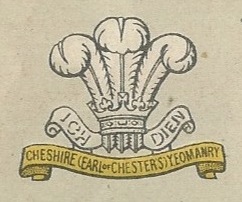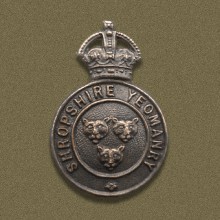The 2nd Mounted Division was a yeomanry division that served in the First World War. At the outbreak of war it was assigned to defence of the Norfolk coast. In March 1915 it formed a 2nd Line duplicate of itself, the 2/2nd Mounted Division. Leaving the 2/2nd on coastal defence, it then fought at Gallipoli from April to December 1915, under the command of Major General William Peyton, before being disbanded in January 1916.

The Cheshire Yeomanry was a yeomanry regiment that can trace its history back to 1797 when Sir John Leicester of Tabley raised a county regiment of light cavalry in response to the growing fears of invasion from Napoleonic France. Its lineage is maintained by C Squadron, the Queen's Own Yeomanry.

The Shropshire Yeomanry was a yeomanry regiment of the British Army, first raised in 1795, which served as a cavalry and dismounted infantry regiment in the First World War and as a cavalry and an artillery regiment in the Second World War. It was then amalgamated with the Shropshire Royal Horse Artillery.
The 3rd Mounted Division was a Yeomanry Division of the British Army active during World War I. It was formed on 6 March 1915 as the 2/2nd Mounted Division, a replacement/depot formation for the 2nd Mounted Division which was being sent abroad on active service. In March 1916, it was renumbered as the 3rd Mounted Division and in July 1916 as the 1st Mounted Division. In September 1917, the division was reorganized as a cyclist formation and redesignated as The Cyclist Division. It remained in the United Kingdom throughout the war and was disbanded in June 1919.
The 1st Mounted Division was a Yeomanry Division of the British Army active during World War I. It was formed in August 1914 for the home defence of the United Kingdom from four existing mounted brigades of the Territorial Force, each of three regiments of Yeomanry. The divisional order of battle changed often, as the 1st Line brigades left for service overseas and were replaced by 2nd Line formations. It was converted to the 1st Cyclist Division in July 1916, and was broken up in November 1916 without being involved in active service. It remained in East Anglia throughout its existence.

The Lincolnshire Yeomanry was a volunteer cavalry unit of the British Army formed in 1794. It saw action in the Second Boer War and the First World War before being disbanded in 1920.
The Royal East Kent Yeomanry was a British Army regiment formed in 1794. It saw action in the Second Boer War and the First World War.

The Queen's Own West Kent Yeomanry was a British Army regiment formed in 1794. It served in the Second Boer War and the First World War. It amalgamated with the Royal East Kent Yeomanry to form the Kent Yeomanry in 1920.
The Royal North Devon Yeomanry was a Yeomanry regiment of the British Army. First raised in 1798, it participated in the Second Boer War and the First World War before being amalgamated with the Royal 1st Devon Yeomanry in 1920 to form the Royal Devon Yeomanry.
The Royal 1st Devon Yeomanry was a Yeomanry regiment of the British Army. First raised in 1794, it participated in the Second Boer War and the First World War before being amalgamated with the Royal North Devon Yeomanry in 1920 to form the Royal Devon Yeomanry.
The 1st Dismounted Brigade was a formation of the British Army in World War I. It was formed in Egypt in February 1916 by absorbing the Lowland and Scottish Horse Mounted Brigades. The brigade was on Suez Canal defences attached to the 52nd (Lowland) Division and was broken up in October 1916.
The 21st Mounted Brigade previously known as the 2/1st Western Mounted Brigade was a 2nd Line yeomanry brigade of the British Army during the First World War. In July 1916 it was converted to a cyclist formation as 14th Cyclist Brigade and in October 1916 was redesignated as 10th Cyclist Brigade. It was still in existence, in Ireland, at the end of the war.
The 17th Mounted Brigade previously known as the 2/1st Welsh Border Mounted Brigade was a 2nd Line yeomanry brigade of the British Army during the First World War. In July 1916 it was converted to a cyclist formation as 10th Cyclist Brigade and in November 1916 was redesignated as 6th Cyclist Brigade. It was still in existence, in Ireland, at the end of the war.
The 20th Mounted Brigade previously known as the 2/1st Lowland Mounted Brigade was a 2nd Line yeomanry brigade of the British Army during the First World War. In July 1916 it was converted to a cyclist formation as 13th Cyclist Brigade and in November 1916 was redesignated as 9th Cyclist Brigade. It was still in existence, in Ireland, at the end of the war.
The Essex Royal Horse Artillery was a Territorial Force Royal Horse Artillery battery that was formed in Essex in 1908. It saw active service during the First World War in Egypt and Palestine from 1916 to 1918, initially as field artillery with 52nd (Lowland) Division before being converted back to horse artillery and serving with the 2nd Mounted / 5th Cavalry Division. A second line battery, 2/1st Essex RHA, served on the Western Front in 1917 and 1918 as part of an Army Field Artillery Brigade.
The Glamorganshire Royal Horse Artillery was a Territorial Force Royal Horse Artillery battery that was formed in Glamorganshire in 1908. It saw active service during the First World War on the Western Front in 1917 and 1918 as part of an Army Field Artillery Brigade. A second line battery, 2/1st Glamorganshire RHA, served in England and Ireland before being broken up in January 1917. Glamorganshire RHA was not reconstituted in the post-war Territorial Force.
A Battery, Honourable Artillery Company is a L118 light gun battery that provides a reserve to 7th Parachute Regiment Royal Horse Artillery. Its predecessor was a horse artillery battery that was formed from Light Cavalry Squadron, HAC, in 1891. It transferred to the Territorial Force in 1908 as artillery support for the London Mounted Brigade.
B Battery, Honourable Artillery Company was a horse artillery battery that was formed from the Field Artillery, HAC in 1899. It transferred to the Territorial Force in 1908 as artillery support for the South Eastern Mounted Brigade.
The Warwickshire Royal Horse Artillery was a Territorial Force Royal Horse Artillery battery that was formed in Warwickshire in 1908. It was the first Territorial Force artillery unit to go overseas on active service, spending the whole of the First World War on the Western Front, mostly with 1st Cavalry Division and 29th Division. A second line battery, 2/1st Warwickshire RHA, also served on the Western Front in 1917 and 1918 as part of an Army Field Artillery Brigade. Post-war it was reconstituted as a Royal Field Artillery battery.

The Nottinghamshire Royal Horse Artillery was a Territorial Force Royal Horse Artillery battery that was formed in Nottinghamshire in 1908. It saw active service during the First World War in the Middle East – in the Senussi Campaign and the Sinai and Palestine Campaign – from 1915 to 1918. A second line battery, 2/1st Nottinghamshire RHA, served in the Mesopotamian Campaign in 1917 and 1918 as a Field Artillery battery. Post-war, it was reconstituted as a Royal Field Artillery battery.




